THE BRIDAL DISH
FRESH AND NATURAL
Est. 2023
100% Plant based organic food
Lorem ipsum dolor sit amet, consectetur adipiscing elit, sed do eiusmod tempor incididunt ut labore et dolore magna.
Felis eget nunc lobortis mattis aliquam faucibus purus in massa. Eget mi proin sed libero enim sed faucibus turpis in. Ornare arcu odio ut sem nulla. Convallis convallis tellus id interdum velit.
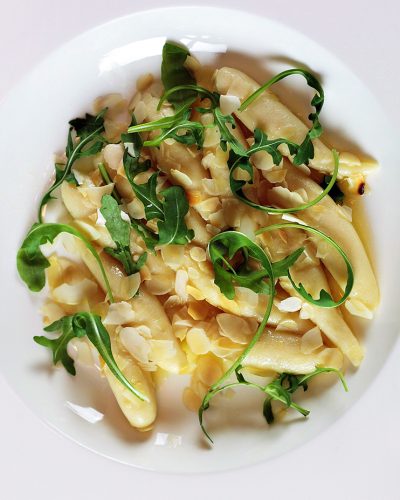

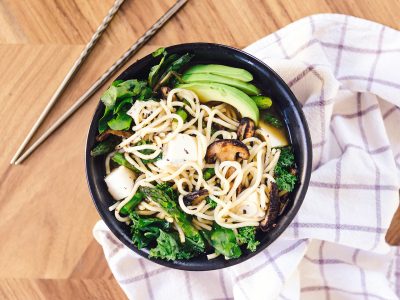
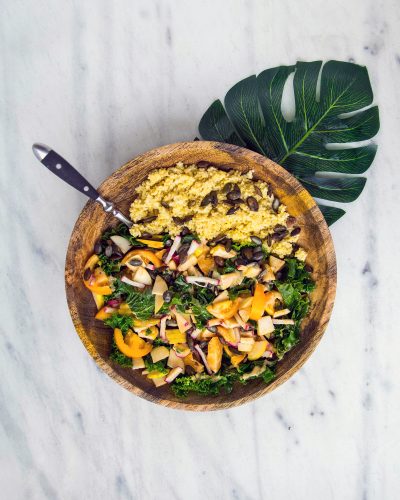
What Is The Most Popular Steak In Melbourne, Australia?
When it comes to culinary delights, Melbourne is a city that knows how to impress. From trendy cafes to high-end dining experiences, Melbourne’s food scene is a melting pot of cultures and flavours.

One dish that stands out among the rest is steak—a timeless favourite that has found a special place in the hearts of Melburnians. Whether you’re a seasoned steak lover or a curious foodie looking to explore the best this city has to offer, understanding what makes a steak popular in Melbourne is key to your gastronomic adventure.
What Is The Most Popular Steak In Melbourne, Australia?
In Melbourne, the steak scene is vibrant and diverse, but one cut has consistently captured the spotlight: the ribeye. Known for its rich marbling and exceptional flavour, the ribeye steak has become a favourite choice among locals and visitors alike. Its popularity can be attributed to a few factors that make it stand out from the rest.
Firstly, the ribeye’s marbling—tiny streaks of fat interspersed within the muscle—melts during cooking, imparting a succulent, buttery flavour that steak enthusiasts crave. This makes the ribeye a juicy, tender cut that is hard to beat when cooked to perfection. Melbourne’s best steakhouses understand this well, offering expertly prepared ribeye steaks that are grilled or pan-seared to achieve a crispy, caramelized crust while keeping the inside tender and moist.
Secondly, the ribeye’s versatility allows it to be paired with a variety of sides and sauces, making it a dynamic choice for any menu. In Melbourne, ribeye steaks are often served with classic accompaniments like garlic butter, chimichurri, or red wine jus, enhancing the meat’s natural flavours. Whether you prefer your ribeye with a side of creamy mashed potatoes or a fresh green salad, there’s no shortage of options to satisfy your taste buds.
Lastly, the ribeye’s adaptability in terms of cooking methods adds to its widespread appeal. Melbourne chefs are skilled at preparing ribeye in different styles, from char-grilled and flame-seared to slow-roasted and smoked, each method bringing out unique qualities of the cut. This flexibility allows steak lovers to experience a range of flavours and textures, ensuring that each visit to a steakhouse offers something new and exciting.
Exploring Melbourne’s Top Steakhouse Experiences
Now that we’ve uncovered the most popular steak in Melbourne, let’s dive into the city’s top steakhouses where you can savour this delightful cut. Melbourne is home to an array of steakhouses, each offering a distinct atmosphere and unique approach to cooking the perfect ribeye.
- Rockpool Bar & Grill: Known for its luxurious setting and commitment to quality, Rockpool Bar & Grill is a top destination for steak lovers. Located in the Crown Entertainment Complex, this upscale steakhouse boasts an impressive selection of ribeye cuts, including grass-fed, grain-fed, and dry-aged varieties. The chefs at Rockpool are meticulous in their preparation, ensuring each steak is cooked to perfection and served with a choice of sides and sauces that complement the meat’s rich flavours.
- The Meat & Wine Co: With several locations across Melbourne, The Meat & Wine Co has made a name for itself as a premier destination for steak enthusiasts. The restaurant offers a range of ribeye steaks sourced from top-quality Australian cattle, and each steak is carefully aged to enhance its flavour and tenderness. What sets The Meat & Wine Co apart is its unique basting technique, which involves marinating the steak in a blend of African-inspired spices and herbs before grilling, giving the ribeye a distinctive taste that is both bold and savoury.
- Steer Dining Room: For a modern take on the classic steakhouse experience, Steer Dining Room is a must-visit. Situated in South Yarra, this contemporary steakhouse specializes in Wagyu ribeye, a premium cut known for its extraordinary marbling and melt-in-your-mouth texture. The restaurant prides itself on sourcing the finest Wagyu beef from Australia and Japan, offering diners a truly indulgent steak experience. Paired with a carefully curated wine list and an elegant dining atmosphere, the Steer Dining Room is the perfect place to enjoy a ribeye steak in style.
The Perfect Sides And Pairings For Your Ribeye Steak
While the ribeye steak is undoubtedly the star of the show, the right sides and pairings can elevate your dining experience to new heights. In Melbourne, steakhouses take great care in curating a selection of sides that complement the flavours and textures of their ribeye offerings.
- Classic Sides: For those who appreciate the timeless appeal of traditional steakhouse fare, classic sides like garlic mashed potatoes, creamed spinach, and crispy fries are a must. These sides provide a comforting contrast to the richness of the ribeye, balancing the meal with their hearty, savoury flavours.
- Modern Twists: If you’re in the mood for something a bit more adventurous, many Melbourne steakhouses offer modern twists on classic sides. Think roasted bone marrow, truffle-infused mac and cheese, or grilled asparagus with hollandaise sauce. These contemporary sides add a touch of sophistication and creativity to your steak dinner, making for a memorable dining experience.
- Wine Pairings: No steak dinner is complete without the perfect wine pairing. Ribeye steaks, with their bold, beefy flavour, pair exceptionally well with full-bodied red wines that can stand up to the meat’s richness. In Melbourne, popular choices include Cabernet Sauvignon, Shiraz, and Malbec, each offering a unique flavour profile that enhances the taste of the ribeye. Many steakhouses have knowledgeable sommeliers on hand to help you select the ideal wine to complement your meal.
Conclusion
In a city known for its diverse culinary landscape, Melbourne’s love affair with steak—particularly the ribeye—continues to thrive. The ribeye’s rich marbling, tender texture, and robust flavour make it the most popular steak choice among Melburnians, and the city’s top steakhouses are experts in bringing out the best in this beloved cut. Whether you’re dining at a high-end establishment or a more casual spot, Melbourne offers an array of steak experiences that cater to every palate.
From expertly prepared ribeye steaks to thoughtfully curated sides and pairings, Melbourne’s steak scene is a testament to the city’s passion for quality and innovation. So, the next time you find yourself in Melbourne and craving a delicious steak, be sure to explore the city’s finest offerings—you won’t be disappointed. Whether you prefer a classic preparation or a modern twist, there’s a ribeye steak waiting to be savoured, and a dining experience ready to be enjoyed.
Ultimately, the popularity of the ribeye steak in Melbourne speaks to more than just a preference for a particular cut of meat; it reflects the city’s broader culinary values. Melbourne is a place where tradition meets innovation, where the quality of ingredients is paramount, and where dining out is as much about the experience as it is about the food itself.
The city’s steakhouses encapsulate this ethos perfectly, providing not just a meal but a memorable occasion every time you sit down to enjoy a perfectly cooked ribeye.
As Melbourne continues to evolve as a culinary capital, the demand for high-quality steak experiences will undoubtedly grow. For visitors and locals alike, the city’s steakhouses offer a taste of Melbourne’s dedication to excellence in food.
Whether you’re a seasoned steak connoisseur or a first-time visitor to the city’s vibrant food scene, exploring the most popular steak in Melbourne—the ribeye—provides a delicious journey into what makes this city a standout destination for food lovers around the world.
Looking for more information? Click this guide “best steak in melbourne 2016”.
What Food Is Melbourne Known For?
A cosmopolitan melting pot with a creative attitude, Melbourne is known as Australia’s culinary capital, and its vibrant and varied food scene is a reflection of that.
The culinary scene in Melbourne is a veritable culinary extravaganza, from the city’s world-renowned coffee culture to its eclectic array of restaurants serving everything from classic Italian trattorias to hip brunch places and secret laneway treasures.

Professional chefs and culinary artisans in this city use food as an artistic medium, fusing international flavours with regional specialties. Melbourne is a gastronomic adventure paradise for locals and tourists alike.
From sipping velvety espresso in lively cafés to sampling dim sum from Chinatown or modern Australian cuisine that highlights local ingredients, there’s something for every palate in this vibrant city.
What Food Is Melbourne Known For?
Melbourne is known for its vibrant food scene with a diverse range of cuisines. Some of the foods Melbourne is famous for include:
- Coffee: Melbourne is renowned for its excellent coffee culture, with numerous specialty coffee shops and cafes offering high-quality brews.
- Avocado Smash: A popular brunch dish consisting of smashed avocado on toast, often topped with various ingredients like poached eggs, feta cheese, or smoked salmon.
- Dim Sum: Melbourne has a thriving Chinatown where you can find delicious dim sum (yum cha) served in traditional tea houses.
- Italian Cuisine: Melbourne has a strong Italian influence, with many authentic Italian restaurants offering pasta, pizza, and gelato.
- Vietnamese Pho: Due to a large Vietnamese community, Melbourne boasts some of the best pho (Vietnamese noodle soup) outside of Vietnam.
- Modern Australian Cuisine: Known for its innovative and fresh approach, blending multicultural influences into dishes that reflect Australia’s diverse culinary heritage.
- Craft Beer and Burgers: Melbourne has a growing craft beer scene, often paired with gourmet burgers that showcase local ingredients.
- Desserts and Bakeries: From French pastries to artisanal doughnuts and decadent cakes, Melbourne offers a wide array of sweet treats.
These are just a few highlights, but Melbourne’s food culture is incredibly diverse and continually evolving, offering something for every taste and preference.
What Is The Speciality Of Melbourne?
Melbourne’s speciality lies in its vibrant, eclectic culture and its status as a hub of creativity and innovation. Here are some of the key specialities that make Melbourne unique:
- Coffee Culture: Melbourne is famous for its exceptional coffee, with a strong emphasis on quality and craftsmanship. The city is home to numerous specialty coffee shops and baristas who take pride in their brewing techniques.
- Arts and Culture: Melbourne is a cultural capital, renowned for its thriving arts scene. It hosts numerous galleries, theatres, live music venues, and festivals throughout the year, including the Melbourne International Comedy Festival and the Melbourne International Film Festival.
- Sporting Events: The city is passionate about sports, hosting major events like the Australian Open (tennis), the Melbourne Cup (horse racing), and the AFL Grand Final (Australian Rules Football).
- Food Scene: Melbourne’s diverse food scene is a reflection of its multicultural population. The city offers a wide range of culinary experiences, from fine dining restaurants to street food markets, with influences from all over the world.
- Laneway Culture: Melbourne’s laneways are famous for their hidden bars, unique boutiques, and vibrant street art. These narrow streets and alleys are a key part of the city’s charm and character.
- Education and Research: The city is home to some of Australia’s leading universities and research institutions, making it a hub for education and innovation.
- Fashion and Design: Melbourne has a strong fashion and design scene, with many local designers and boutiques. The city hosts events like Melbourne Fashion Week, showcasing emerging and established talent.
- Public Transportation: Melbourne’s extensive public transportation network, including its iconic trams, makes it easy to navigate and explore the city.
These specialities contribute to Melbourne’s reputation as a dynamic, cosmopolitan city that offers something for everyone, whether you’re a local or a visitor.
Are There Southbank Restaurants In Melbourne?
Yes, Southbank in Melbourne is home to a variety of restaurants, offering a wide range of dining experiences. Located along the southern bank of the Yarra River, this vibrant precinct features a mix of fine dining establishments, casual eateries, and trendy bars. Some popular options in southbank restaurants melbourne include:
- The Atlantic: Specializing in seafood, this restaurant offers a sophisticated dining experience with stunning views of the river.
- Rosetta: A high-end Italian restaurant by renowned chef Neil Perry, known for its authentic Italian dishes and extensive wine list.
- Dinner by Heston Blumenthal: An outpost of the famous British chef’s restaurant, offering a unique menu inspired by historic British cuisine.
- Ponyfish Island: A quirky bar and eatery located on a small island under the Southbank pedestrian bridge, offering casual bites and drinks with a great view.
- Nobu: Part of the famous international chain, Nobu Melbourne serves modern Japanese cuisine with a Peruvian twist in a sleek and stylish setting.
- Eureka 89: Located on the 89th floor of the Eureka Tower, this fine dining restaurant offers a modern Australian menu and panoramic views of the city.
- Melbourne Public: A popular spot for casual dining and drinks, offering a relaxed atmosphere with a menu featuring classic pub fare.
- Pure South Dining: Focused on fresh produce from Tasmania, this restaurant offers a menu showcasing the best of Tasmanian and King Island ingredients.
These are just a few examples, but Southbank has many more dining options to explore, making it a popular destination for both locals and tourists seeking a memorable culinary experience.
Conclusion
If you’re looking for a wide variety of restaurants in Melbourne that can accommodate any occasion or palate, go no further than Southbank. Southbank features the finest of Melbourne’s vibrant culinary scene, from upscale fine dining to informal cafes with breathtaking river views.
A gastronomic trip reflecting the city’s colourful and multicultural spirit awaits you on Southbank, where you may indulge in seafood at The Atlantic, relish Italian delicacies at Rosetta, or enjoy the unusual selections at Dinner by Heston Blumenthal. Southbank is a must-visit location for foodies in search of Melbourne’s diverse culinary scene.
Adding to the allure of this lively riverside sector is the fact that Southbank is not only home to a wide variety of dining establishments, but it is also a centre for cultural and entertainment activities.
The neighbourhood is home to several important attractions, such as the National Gallery of Victoria, which is Australia’s oldest and most visited art museum, and the Arts Centre Melbourne, which is known for putting on world-class performances in the fields of music, ballet, and theatre.
The Southbank Promenade is a beautiful section of the city that offers visitors the opportunity to take a stroll while taking in the vibrant ambience that includes street performers, public art pieces, and breathtaking views of the city skyline.
With its assortment of high-end restaurants, bars, a casino, and a wide range of entertainment alternatives, such as a movie theatre and live performances, the Crown Melbourne complex, which is a significant feature of Southbank, provides a sumptuous experience for its patrons.
Southbank is a bright and crucial component of Melbourne’s identity, pulling both locals and tourists to its dynamic and appealing atmosphere. This blend of cultural, culinary, and entertainment events makes Southbank a part of Melbourne’s identity that is both essential and exciting.
The Southbank has something to offer everyone, whether you are looking for a sophisticated night out, a relaxed meal by the river, or an intensive cultural experience. Southbank has something to offer everyone.
Greek Cuisine in Australia
Australia is a melting pot of cultures, and the Greek community has significantly contributed to its vibrant culinary landscape. Greek cuisine, with its rich history and diverse flavours, has found a special place in the hearts and taste buds of Australians. This article explores some of the most popular Greek dishes and traditional dining habits that are celebrated in Greek restaurants across Australia.

The Greek Influence in Australia
Greek immigration to Australia began in the early 19th century, with a significant influx occurring after World War II. This wave of immigrants brought with them their rich culinary traditions, which have since become an integral part of Australia’s food scene. Greek restaurants, cafes, and delis are now common in cities like Melbourne, Sydney, and Brisbane, offering Australians an authentic taste of Greece.
Popular Greek Dishes in Australian Restaurants
1. Souvlaki
One of the most beloved Greek dishes in Australia is souvlaki. This dish consists of skewered and grilled meat, typically served with pita bread, salad, and a generous dollop of tzatziki sauce. Lamb, chicken, and pork are the most common meats used. Souvlaki is popular for its simplicity and robust flavours, making it a favourite among Australians looking for a quick, yet satisfying meal.
2. Moussaka
Moussaka is another staple in Greek restaurants across Australia. This hearty dish is similar to lasagna but uses layers of eggplant or potato, ground meat (often lamb), and béchamel sauce. It’s baked to perfection, resulting in a creamy, savoury dish that is both comforting and delicious. Moussaka’s rich flavours make it a favourite for those looking to indulge in a traditional Greek meal.
3. Spanakopita
Spanakopita, a savoury spinach pie, is a popular appetizer or snack in Greek eateries. Made with layers of crispy phyllo dough filled with spinach, feta cheese, onions, and herbs, it’s a delightful combination of textures and flavours. Spanakopita showcases the Greek mastery of phyllo pastry, making it a must-try dish for newcomers to Greek cuisine.
4. Gyro
Similar to souvlaki, the gyro is a ubiquitous Greek dish that has found immense popularity in Australia. Gyros are made from meat cooked on a vertical rotisserie, typically lamb, beef, or chicken, and are served on pita bread with tomatoes, onions, and tzatziki. The combination of well-seasoned meat and fresh accompaniments makes gyros a popular choice for a quick and satisfying meal.
5. Dolmades
Dolmades are grape leaves stuffed with a mixture of rice, herbs, and sometimes ground meat. These bite-sized parcels are often served as appetizers and are beloved for their tangy and aromatic flavour profile. In Greek restaurants in Australia, dolmades are often served with a side of lemon wedges or yogurt sauce, adding to their zesty appeal.
6. Greek Salad
A quintessential Greek salad, or horiatiki, is a refreshing and healthy option commonly found in Greek restaurants. It typically includes tomatoes, cucumbers, red onions, olives, and feta cheese, all dressed with olive oil, oregano, and sometimes vinegar. The simplicity and freshness of a Greek salad make it a perfect accompaniment to any meal.
7. Baklava
For dessert, baklava is a popular choice in Greek restaurants across Australia. This sweet pastry is made of layers of phyllo dough, filled with chopped nuts and sweetened with honey or syrup. Its rich, buttery, and sweet flavours make it a delightful end to any Greek meal. Baklava is often served with a cup of strong Greek coffee, enhancing the overall dining experience.
Traditional Greek Dining Habits in Australia
1. Meze Culture
One of the most cherished aspects of Greek dining is the tradition of meze. Meze refers to a variety of small dishes served as appetizers, similar to Spanish tapas. This communal style of eating is popular in Greek restaurants in Australia, where diners can sample a range of flavours and dishes.
Popular meze items include olives, cheese, dips like tzatziki and hummus, grilled octopus, and fried calamari. Sharing meze is not just about the food, but also about the social experience, encouraging conversation and enjoyment among friends and family.
2. Family-style Dining
Greek dining emphasizes family-style meals, where large dishes are shared at the table. This tradition is prevalent in Greek restaurants in Australia, where patrons are encouraged to order several dishes to share. This communal approach to dining reflects the Greek values of togetherness and hospitality, making the meal more about the experience and connection than just the food.
3. Celebrations and Feasts
Greek culture is known for its celebrations and feasts, which often involve a lot of food, music, and dancing. Greek restaurants in Australia frequently host events that celebrate Greek holidays, such as Easter, Christmas, and the annual Greek Festival. These events offer Australians a chance to experience traditional Greek festivities, complete with special dishes like lamb on the spit, kourabiedes (almond cookies), and vasilopita (New Year’s cake).
4. Use of Fresh and Local Ingredients
Greek cuisine is known for its use of fresh and local ingredients, a practice that is maintained in Greek restaurants in Australia. Ingredients like olive oil, fresh vegetables, herbs, and seafood are staples in Greek cooking. Many Greek restaurants in Australia source their produce locally, ensuring the dishes are not only authentic but also fresh and sustainable.
5. Greek Coffee and Dessert Culture
In Greece, coffee and desserts play a significant role in social life. This tradition has been carried over to Greek restaurants in Australia, where Greek coffee and a variety of desserts are offered. Greek coffee is strong and usually served with a glass of water. It is an essential part of Greek hospitality and is often accompanied by a sweet treat like baklava, loukoumades (honey puffs), or galaktoboureko (custard pie).
Greek Festivals and Their Impact on Australian Cuisine
Greek festivals in Australia, such as the Lonsdale Street Greek Festival in Melbourne and the Greek Festival of Sydney, have had a profound impact on the popularity of Greek cuisine. These festivals celebrate Greek culture, music, dance, and, most importantly, food.
They provide a platform for Greek restaurants to showcase their dishes, attracting food enthusiasts from all over the country. Festival-goers can enjoy a wide range of Greek delicacies, participate in cooking demonstrations, and learn about the history and traditions behind the food.
The Future of Greek Cuisine in Australia
The future of Greek cuisine in Australia looks promising, with a growing appreciation for its rich flavours and healthy ingredients. Greek restaurants are continually innovating while staying true to traditional recipes. There is a trend towards modern Greek cuisine, where chefs are experimenting with contemporary techniques and presentations, without compromising the authenticity of the flavors.
Additionally, the rise of vegan and vegetarian diets has seen Greek cuisine adapt, offering more plant-based options that draw on traditional dishes like fasolada (bean soup) and briam (roasted vegetables).
Conclusion
Greek cuisine has become a cherished part of Australia’s culinary landscape, offering a blend of traditional flavours and communal dining experiences. From the hearty moussaka and flavorful souvlaki to the sweet allure of baklava, Greek dishes have found a special place in the hearts of Australians.
The traditional dining habits, such as meze and family-style meals, reflect the Greek values of hospitality and togetherness, making dining at a Greek restaurant an experience beyond just the food. As Greek festivals continue to celebrate and promote this rich culinary heritage, the love for Greek cuisine in Australia is set to grow even stronger, promising an exciting future for both traditional and modern Greek food enthusiasts. Let’s find some restaurants here at greek food perth.
What Is The Quietest Day For Restaurants?
To maximize efficiency and profit in the fast-paced restaurant industry, it is crucial to identify client trends. What is the least busy day for restaurants? This is a question that many restaurant owners and managers ask. Decisions about personnel, stock management, and marketing tactics can all be greatly impacted by this information.

Even while restaurants are usually quite busy, there are days when the noise level drops, providing a rare opportunity for quiet. This article explores the causes of slower times in the restaurant industry, looks at current trends, and offers advice on how restaurants should make the most of these slower times.
What Is The Quietest Day For Restaurants?
In the bustling world of the restaurant industry, certain patterns of customer behaviour can make a significant impact on business operations. Among these patterns, identifying the quietest day of the week for restaurants is particularly valuable. Industry data and anecdotal evidence suggest that certain days consistently see lower customer traffic. Here are a few examples:
- Mondays: Often regarded as the least busy day for dining establishments, Mondays see a significant dip in patronage. After the weekend rush, many people prefer to start their week with meals at home, leading to quieter evenings in restaurants.
- Tuesdays: Similar to Mondays, Tuesdays can also experience lower customer traffic. While some restaurants run special promotions to attract diners, the overall turnout is usually modest compared to busier days later in the week.
- Mid-Afternoon on Weekdays: Beyond specific days, there are also quieter times within each day. The period between the lunch rush and dinner service, typically from 2 PM to 5 PM, is often slow. This lull gives staff a chance to prepare for the evening rush.
Understanding these quieter periods allows restaurant owners and managers to optimize staffing, manage inventory efficiently, and implement strategic promotions to boost business during these slower times. This article explores the factors contributing to these quieter days and times, examines industry trends, and offers practical tips for making the most of them in the restaurant business.
Are There Any Quiet Restaurants In Melbourne?
Yes, Melbourne offers several quiet restaurants where diners can enjoy a peaceful meal away from the hustle and bustle. Here are a few notable options when looking for quiet restaurants melbourne:
- Coda: Located in the heart of Melbourne’s CBD, Coda offers a sophisticated dining experience with a relaxed atmosphere. Its layout and attentive service contribute to a quieter dining environment ideal for conversation.
- The Town Mouse: Situated in Carlton, The Town Mouse is known for its intimate setting and focus on seasonal, locally sourced ingredients. The ambience here tends to be calm and conducive to enjoying a leisurely meal.
- Attica: While Attica is renowned for its exceptional cuisine and Michelin-starred dining experience, it also provides a serene atmosphere where guests can savour their meals without distractions.
- The European: Nestled in Melbourne’s cultural precinct, The European combines elegance with a quieter ambience, making it suitable for those seeking a refined dining experience.
- Vue de Monde: Located on the 55th floor of the Rialto building, Vue de Monde offers stunning views of Melbourne along with a serene dining atmosphere perfect for special occasions.
These restaurants not only focus on culinary excellence but also provide quieter spaces where diners can enjoy their meals in a more tranquil setting. It’s advisable to check availability and make reservations, especially during peak times, to ensure the best experience.
What Foods Is Melbourne Famous For?
Melbourne, known for its vibrant food scene influenced by multiculturalism and a focus on quality ingredients, is famous for several distinctive foods and dining experiences:
- Coffee: Melbourne is renowned for its coffee culture, with numerous specialty coffee shops and cafes scattered throughout the city. Melburnians take their coffee seriously, and you can find excellent espresso, flat whites, and pour-over brews.
- Brunch: The city is famous for its brunch culture, offering a wide range of options from avocado toast and smashed avocado dishes to elaborate breakfast boards and innovative twists on classic brunch items.
- Asian Cuisine: Melbourne boasts a diverse range of Asian cuisines, including Chinese, Vietnamese, Thai, Japanese, and Korean. Areas like Chinatown and Richmond are particularly known for their authentic Asian eateries.
- Italian Food: With a strong Italian heritage, Melbourne offers fantastic Italian cuisine, from traditional pasta dishes to contemporary interpretations served in stylish trattorias and fine dining establishments.
- Seafood: Being close to the ocean, Melbourne is renowned for its fresh seafood. Popular dishes include fish and chips, seafood platters, and seafood risotto, showcasing locally sourced ingredients.
- Gourmet Burgers: Melbourne has a thriving burger scene, with many places serving up gourmet burgers with creative toppings, quality meats, and artisanal buns.
- Fine Dining: The city hosts a plethora of world-class fine dining restaurants offering innovative menus, often featuring locally sourced produce and international culinary influences.
- Street Food and Food Markets: Melbourne’s food markets, such as Queen Victoria Market and South Melbourne Market, are famous for their diverse range of street food stalls, offering everything from fresh oysters and gourmet pies to international street eats.
Melbourne’s food scene is celebrated for its diversity, quality, and innovation, making it a paradise for food enthusiasts seeking both traditional and contemporary culinary experiences.
Is Melbourne A Foodie City?
Yes, Melbourne is widely regarded as a foodie city and has earned its reputation as a culinary hotspot both locally and internationally. Here are several reasons why Melbourne is considered a foodie paradise:
- Diverse Culinary Scene: Melbourne’s food scene is incredibly diverse, offering a wide range of cuisines from around the world. Whether you’re craving Asian street food, authentic Italian pasta, Middle Eastern mezze, or modern Australian fusion dishes, Melbourne has it all.
- Coffee Culture: Melbourne is famous for its thriving coffee culture. The city boasts numerous specialty coffee shops, roasteries, and cafes where you can enjoy expertly brewed espresso, flat whites, and pour-over coffees.
- Award-Winning Restaurants: Melbourne is home to numerous award-winning restaurants, including those recognized with prestigious chef hats and Michelin stars. These establishments showcase innovative menus, use high-quality local ingredients, and offer exceptional dining experiences.
- Food Markets: Melbourne’s food markets, such as Queen Victoria Market and South Melbourne Market, are iconic destinations for food lovers. They feature a vast array of fresh produce, gourmet delights, artisanal products, and street food stalls.
- Brunch Culture: Melburnians love brunch, and the city is known for its vibrant brunch scene. Many cafes and restaurants offer creative and indulgent brunch menus, making it a weekend ritual for locals and a must-try experience for visitors.
- Food Festivals and Events: Throughout the year, Melbourne hosts numerous food festivals and events celebrating everything from coffee and chocolate to multicultural cuisines and wine. These events showcase Melbourne’s culinary diversity and bring together food enthusiasts from near and far.
- Innovation and Trends: Melbourne’s chefs and restaurateurs are known for their innovation and willingness to experiment with flavours, techniques, and dining concepts. This spirit of creativity contributes to Melbourne’s dynamic food scene and keeps it at the forefront of global food trends.
Melbourne’s passionate embrace of food, coupled with its cultural diversity, commitment to quality, and innovative spirit, solidifies its status as a top destination for foodies seeking unforgettable culinary experiences.
Conclusion
An eclectic mix of multiculturalism, a passion for fresh, high-quality ingredients, and a penchant for culinary creativity make up Melbourne’s vibrant culinary culture. With its world-famous coffee culture, eclectic Asian cuisine, mouth-watering Italian specialties, and plenty of fresh seafood, Melbourne provides a culinary adventure that suits every taste.
Melbourne is known as a world-class culinary destination thanks to its lively food scene, which includes trendy cafes, world-class fine dining restaurants, and lively food markets. Whether you’re looking for a spot to have a leisurely brunch, indulge in gourmet burgers, or discover foreign street food, Melbourne’s diverse and constantly growing cuisine never fails to delight.
What Is The Most Popular Food In Sydney Australia?
A reflection of Sydney’s ethnic past and innovative spirit is the city’s dynamic and varied food scene. This lively metropolis is a paradise for foodies because of its booming food culture, which serves up a medley of international flavours. With its crowded Chinatown lanes and posh harbour eateries, Sydney offers a diverse range of cuisines to satisfy any taste. Some dishes, though, have come to symbolise Sydney’s distinct character among this eclectic mix.

We explore the gastronomic landscape of Sydney and unearth the delicacies that have captured the hearts and taste buds of locals and visitors alike in this article, which delves into the most popular foods in Sydney. The gastronomic appeal of Sydney is defined by its uniquely Australian classics and global dishes with a local touch. No visitor to this dynamic city should miss the opportunity to sample these dishes.
What Is The Most Popular Food In Sydney Australia?
Sydney’s culinary landscape is a melting pot of diverse cultures, which makes it difficult to pinpoint a single “most popular” food. However, a few foods and dishes are iconic in Sydney and loved by locals and tourists alike. Here are some of them:
- Fish and Chips: Given Sydney’s coastal location, fresh seafood is a staple, with fish and chips being a classic and ubiquitous favourite. You’ll find it in beachside shacks and upscale eateries alike.
- Sydney Rock Oysters: Native to the region, these oysters are highly sought after for their unique flavour profile. They are often served fresh with a squeeze of lemon or a dash of mignonette sauce.
- Meat Pies: A quintessential Australian snack, meat pies are popular throughout Sydney. The flaky pastry filled with savoury meat gravy is a go-to for many Sydneysiders, especially during sporting events or casual outings.
- Asian Fusion Cuisine: With a large Asian population, Sydney has a vibrant Asian food scene. Dishes like dumplings, sushi, and banh mi have become staples in the city’s dining culture.
- Lamingtons: This beloved dessert consists of sponge cake coated in chocolate and rolled in coconut. It’s a classic Australian treat that has a special place in Sydney’s heart.
- Barbecue and Grilled Dishes: Australian barbecue, or “barbie,” is a cultural phenomenon. Grilled meats like sausages (“snags”), steaks, and seafood are popular at family gatherings and public parks.
While these foods are among the most popular in Sydney, the city’s culinary diversity means there’s always something new to discover, from high-end restaurants to food trucks and markets. If you’re visiting Sydney, exploring its vibrant food scene is an adventure you won’t want to miss.
What Is The Culture In Sydney, Australia?
Sydney, Australia, is a vibrant and multicultural city with a rich cultural landscape shaped by its history, diverse population, and geographical location. Here’s an overview of Sydney’s culture, covering various aspects such as people, lifestyle, arts, food, and more:
- Diversity and Multiculturalism: Sydney is one of Australia’s most diverse cities, with people from various cultural backgrounds and nationalities. This multiculturalism is reflected in the city’s neighbourhoods, languages, festivals, and food. The presence of large immigrant communities, especially from Asia, Europe, and the Middle East, contributes to the city’s vibrant atmosphere.
- Laid-Back Lifestyle: Sydneysiders are known for their relaxed and laid-back lifestyle. The city’s beautiful beaches, parks, and outdoor spaces encourage a culture that values leisure and work-life balance. Activities like surfing, beach volleyball, and sailing are popular among locals.
- Art and Creativity: Sydney has a thriving arts scene, with institutions like the Sydney Opera House, the Art Gallery of New South Wales, and the Museum of Contemporary Art playing central roles. The city hosts numerous cultural events and festivals, including the Sydney Festival, Vivid Sydney, and the Sydney Film Festival, which draws international attention.
- Food and Dining: Sydney’s multiculturalism has given rise to a diverse culinary landscape. The city offers a range of dining experiences, from upscale restaurants with world-class chefs to street food markets that celebrate international cuisines. Popular food markets like the Sydney Fish Market and the Carriageworks Farmers Market attract both locals and tourists.
- Sports and Outdoor Activities: Sports are an integral part of Sydney’s culture. Rugby, cricket, soccer, and Australian Rules football are widely followed, and Sydney hosts major sporting events such as the Sydney to Hobart Yacht Race and the Sydney Marathon. The city’s outdoor culture also promotes activities like hiking, cycling, and running, with iconic spots like the Bondi to Coogee coastal walk.
- History and Indigenous Culture: Sydney has a rich history, with Indigenous Australian culture playing an important role. The city is home to the Eora Nation, and Indigenous heritage is celebrated through events, art, and cultural sites. The history of European settlement and colonization is also evident in the city’s architecture and landmarks, such as The Rocks and Hyde Park Barracks.
Sydney’s culture is a dynamic blend of tradition and innovation, shaped by its natural beauty, diverse population, and commitment to creativity and inclusivity. This makes the city a vibrant and engaging place to live, work, and visit.
What Is Sydney Unique For?
Sydney, Australia’s largest city, is unique for a variety of reasons that distinguish it from other global cities. Here’s a comprehensive list of what makes Sydney unique:
- Iconic Landmarks: Sydney is home to some of the most recognizable landmarks in the world, including the Sydney Opera House and the Sydney Harbour Bridge. These structures not only define the city’s skyline but also symbolize its rich cultural and architectural heritage.
- Stunning Natural Beauty: Sydney boasts an incredible natural landscape, with pristine beaches, the sprawling Sydney Harbour, and the nearby Blue Mountains. This natural beauty provides a unique backdrop to urban life and contributes to the city’s outdoor-oriented culture.
- Multiculturalism and Diversity: Sydney is one of the most multicultural cities in Australia, with a population that represents a diverse range of cultures and backgrounds. This diversity is reflected in the city’s neighbourhoods, food scenes, festivals, and cultural events, creating a unique and vibrant social tapestry.
- Outdoor Lifestyle: Sydney is known for its laid-back, outdoor-oriented lifestyle. The city’s residents enjoy a range of outdoor activities, from surfing at Bondi Beach to hiking in the Blue Mountains. This focus on outdoor living contributes to Sydney’s unique atmosphere.
- Vibrant Arts and Cultural Scene: Sydney has a thriving arts and cultural scene, with institutions like the Sydney Opera House, the Art Gallery of New South Wales, and the Museum of Contemporary Art. The city also hosts major events such as the Sydney Festival and Vivid Sydney, attracting artists and performers from around the world.
- Unique Wildlife and Nature: Sydney’s proximity to national parks and reserves allows residents and visitors to experience Australia’s unique wildlife. From spotting kangaroos and koalas to exploring the diverse marine life in the Sydney Harbour, the city’s natural environment offers unique opportunities for nature enthusiasts.
- World-Class Events and Activities: Sydney is a hub for major events, from New Year’s Eve fireworks over the Sydney Harbour Bridge to the Sydney Gay and Lesbian Mardi Gras, one of the largest LGBTQ+ celebrations in the world. The city’s calendar is filled with events that reflect its dynamic and inclusive culture.
Sydney’s unique combination of iconic landmarks, natural beauty, multiculturalism, outdoor lifestyle, vibrant arts scene, and unique wildlife make it a city like no other. It’s a place where tradition and innovation coexist, offering a diverse and engaging experience for residents and visitors alike.
Conclusion
The city of Sydney is unique because it possesses the rare ability to blend old and new, urban and natural, cultural diversity and relaxation. Visitors come from all over the globe to see its famous sites, enjoy its thriving arts scene, and enjoy the great outdoors, and the city’s multiculturalism helps to create a special feeling of belonging for everyone. Sydney offers something for everyone, whether it’s the beautiful beaches, the exciting events, or the world-class restaurants.
Sydney, one of Australia’s most vibrant cities, is always changing and introducing new things to do while yet paying homage to its storied past. With its vibrant Central Business District and serene harbour coastlines, Sydney is a city that begs to be explored and rewards inquisitiveness. Sydney is a wonderful place to live and visit, so it’s no surprise that so many people adore it. There is no doubt that a visit to Sydney, with all its attractions, will be an unforgettable experience.
Click “best asian restaurants sydney 2016” to know more!
What Is The Most Famous French Dinner?
There is one supper that stands out as the essence of French gastronomy, and that is the classic French dinner. French cuisine is known all over the world for its sophistication, richness, and delicacy, and among its numerous gastronomic delights, there is one evening that stands out.
With its painstakingly planned courses, artistic presentation, and concentration on fresh, seasonal ingredients, this renowned dining experience exemplifies the spirit of the French culinary culture. Come along with us as we delve into the appeal and refinement of the most famous French meal, where each mouthful is a trip through the flavours that have been passed down through the culinary legacy of France.
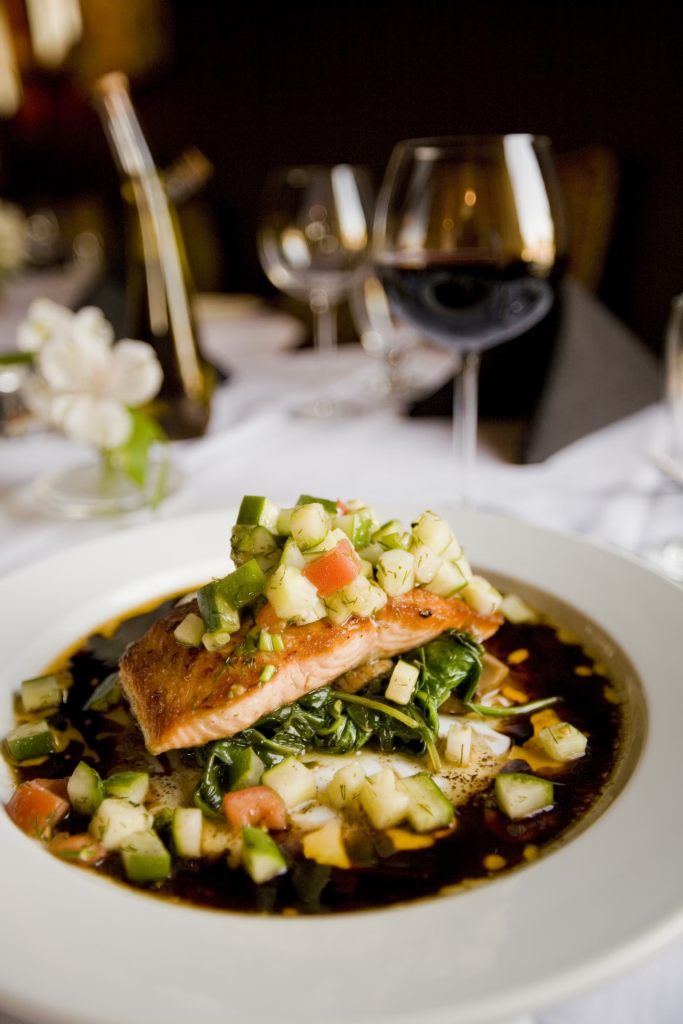
What Is The Most Famous French Dinner?
Perhaps the most well-known French supper is “Le dîner gastronomique à la française,” also known as “The French Gastronomic Dinner.” It’s more like a multi-course meal with a variety of dishes such as hors d’oeuvres, soup, meat, fish, cheese, dessert, and coffee rather than just one dish. This lavish meal provides a demonstration of the variety, complexity, and wealth of French food.
Careful preparation goes into each meal, which frequently showcases seasonal delicacies and regional specialities; wines are chosen to enhance the flavours. Guests at the French Gastronomic Dinner are invited to partake in a multi-sensory extravaganza honouring the culinary arts, French heritage, and the joys of sharing a meal with friends and family.
Here’s a breakdown of a traditional French Gastronomic Dinner:
- Hors d’oeuvres (Appetizers): The meal typically begins with a selection of small, savoury bites served as appetizers. This could include items like pâté, terrine, smoked salmon, or a variety of canapés.
- Soup: Following the appetizers, a warm and comforting soup is often served. Classic options include French onion soup, vichyssoise (potato and leek soup), or bouillabaisse (a traditional Provençal fish stew).
- Fish Course: Next comes a seafood dish, showcasing the bounty of the sea. This could be a delicate fillet of fish, such as sole or sea bass, prepared with a flavorful sauce and accompanied by seasonal vegetables.
- Meat Course: The main course typically features meat, such as beef, lamb, poultry, or game, prepared in a variety of ways. Coq au vin (chicken braised in wine), boeuf bourguignon (beef stewed in red wine), or duck confit are classic examples.
- Cheese Course: A selection of fine cheeses from various regions of France is often presented after the main course. This course allows diners to savour the distinct flavours and textures of different cheeses, accompanied by crusty bread or crackers.
- Dessert: The meal culminates with a decadent dessert, showcasing French pastry craftsmanship. This could be a classic like crème brûlée, tarte Tatin, mille-feuille, or a selection of petits fours.
- Coffee and Digestifs: Finally, the meal concludes with coffee or espresso, often served alongside a selection of digestives such as Cognac, Armagnac, or liqueurs like Grand Marnier or Chartreuse. These help aid digestion and provide a satisfying end to the dining experience.
Throughout the dinner, great care is taken to pair each course with appropriate wines, chosen to enhance the flavours of the food and elevate the overall dining experience. The French Gastronomic Dinner is not just about sustenance; it’s a celebration of culinary artistry, culture, and conviviality that embodies the essence of French gastronomy.
Where To Find The Best French Restaurant In Sydney?
Determining the “best” French restaurant in Sydney can be subjective and depends on individual tastes and preferences. However, there are several highly regarded French restaurants in Sydney known for their authentic cuisine, ambience, and service. Here are a few options for the best french restaurant sydney:
- Felix Restaurant: Located in the heart of Sydney’s CBD, Felix Restaurant offers a classic French brasserie experience. With its elegant Parisian-inspired décor and a menu featuring traditional French dishes like steak frites, bouillabaisse, and escargot, Felix captures the essence of French dining.
- Hubert: This underground French bistro transports diners to 1930s Paris with its dimly lit ambience, vintage décor, and live jazz music. Hubert’s menu features French classics with a modern twist, including coq au vin, duck confit, and steak tartare.
- Bistro Moncur: Situated in Woollahra, Bistro Moncur is a cozy neighbourhood bistro known for its refined French cuisine and warm hospitality. The menu showcases French-inspired dishes made with locally sourced ingredients, and the restaurant offers an extensive wine list featuring French and Australian wines.
- Est: With its chic dining room and innovative French-inspired menu, Est is a favourite among Sydney’s culinary enthusiasts. Located in the Establishment Hotel, Est offers a fine dining experience with dishes like foie gras parfait, lobster bisque, and confit duck leg.
- Bistro Rex: This charming bistro in Potts Point offers a relaxed atmosphere and a menu featuring French classics made with seasonal Australian produce. Diners can enjoy dishes like bouillabaisse, steak tartare, and coq au vin in a stylish yet unpretentious setting.
These are just a few options to consider, but there are many other excellent French restaurants in Sydney worth exploring. It’s always a good idea to check reviews, ask for recommendations, and make reservations in advance, especially for popular dining spots.
Is French Restaurant Worth It?
Whether a French restaurant is “worth it” depends on various factors, including personal preferences, budget, and the specific restaurant in question. Here are some points to consider:
- Cuisine and Experience: French cuisine is renowned for its sophistication, flavour, and technique. Dining at a French restaurant can provide an opportunity to indulge in classic dishes prepared by skilled chefs who specialize in French culinary traditions. The experience can be particularly enjoyable for those who appreciate fine dining and are interested in exploring different flavours and ingredients.
- Ambience and Atmosphere: French restaurants often pride themselves on creating an elegant and intimate dining environment. From cozy bistros to upscale fine dining establishments, the ambience and atmosphere can contribute significantly to the overall dining experience, making it worth it for those seeking a special occasion or romantic night out.
- Quality of Ingredients and Service: Many French restaurants prioritize using high-quality, fresh ingredients and providing attentive service to ensure a memorable dining experience. This attention to detail can justify the higher prices often associated with dining at French restaurants.
- Cost Considerations: Dining at a French restaurant can be more expensive compared to eating at casual dining establishments. However, for some people, the culinary experience, ambience, and level of service justify the cost. It’s essential to consider your budget and what you’re comfortable spending on dining out.
- Personal Preferences: Ultimately, whether a French restaurant is worth it depends on individual preferences and priorities. Some diners may prefer the simplicity and affordability of casual dining, while others may enjoy the sophistication and indulgence of a fine dining experience.
Dining at a French restaurant can be worth it for those who appreciate the cuisine, ambience, and overall experience it offers. However, it’s essential to consider factors such as cost, personal preferences, and occasion when deciding whether to dine at a French restaurant.
Conclusion
French restaurants provide a one-of-a-kind eating experience that is distinguished by the excellent cuisine, stylish atmosphere, and attentive service featured in these establishments.
Customers may anticipate indulging in traditional French cuisine that is made with both high-quality ingredients and a high level of culinary expertise, regardless of whether they are dining at a quaint cafe or an upmarket fine dining restaurant.
Even though dining in French restaurants may come with a higher price tag, many people believe that the opportunity to experience exquisite flavours, take pleasure in elegant surroundings, and make memories that will last a lifetime justifies the investment.
The ultimate determination of whether or not a French restaurant is worth the expense is contingent upon the tastes of the individual, the constraints of the budget, and the desire to have a unique dining experience.
What Is The Most Popular Pizza In Australia?
Discovering the pizza that is most popular in Australia can be as varied as the country’s environment. From the crowded streets of Melbourne to the sandy coasts of Sydney, Australians have acquired a distinct taste for this well-liked Italian dish.
This is because of the country’s diverse cultural backgrounds. Come along with us as we explore the enticing world of Australian pizza culture, during which we will discover the flavours and ingredients that have won the hearts (and stomachs) of pizza aficionados all around the country.
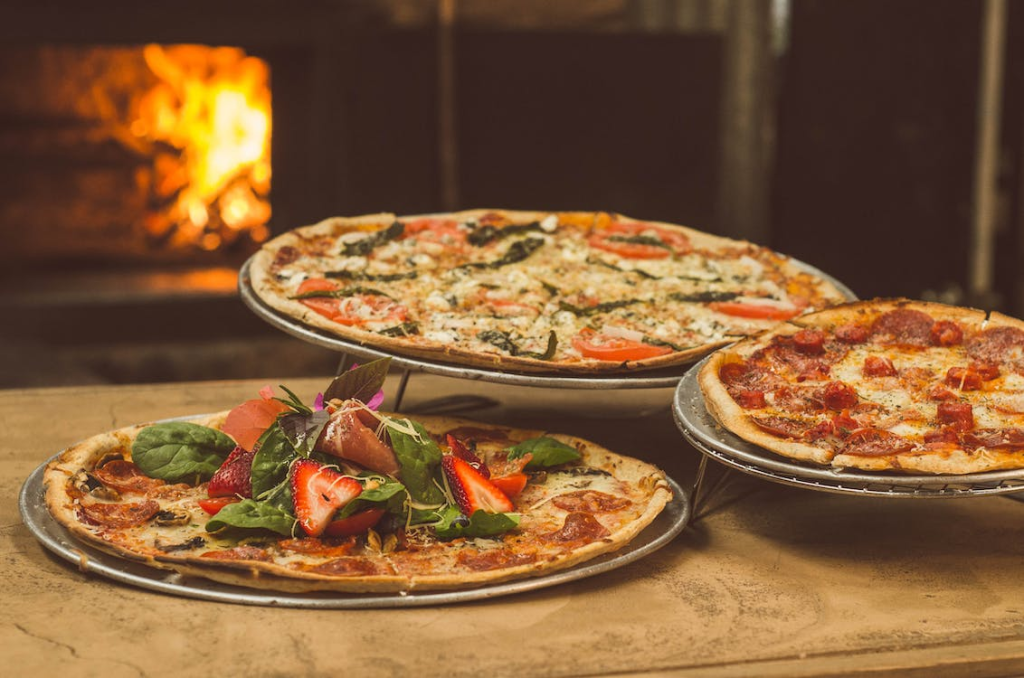
Pizza | What Is It?
Pizza has captured the hearts and stomachs of people all around the globe. A classic pizza, with its round, pressed dough foundation, tomato sauce, cheese, and an assortment of toppings like meats, veggies, and herbs, has its origins in Italy. The classic recipe calls for wheat flour, water, yeast, and salt to make the dough, which, when heated in an oven, turns into a crust that is chewy and crispy at the same time.
Although traditional pizzas like Margherita and Pepperoni continue to sell well, pizza’s adaptability encourages ingenuity in the kitchen and beyond as people try new toppings and flavour combinations. Whether it’s a fast and easy dinner, the showpiece at parties, or a cosy treat, pizza has always had a unique place in culinary history, drawing people together across countries and cultures.
What Is The Most Popular Pizza In Australia?
It’s challenging to pinpoint a single pizza as the absolute most popular across all of Australia, as preferences can vary greatly depending on region and individual taste. However, some classic favourites and popular choices include:
- Margherita: A timeless classic featuring tomato sauce, mozzarella cheese, fresh basil, and sometimes a drizzle of olive oil. Its simplicity and balanced flavours make it a popular choice among pizza lovers.
- Supreme: Loaded with toppings such as pepperoni, mushrooms, onions, bell peppers, and olives, the Supreme Pizza offers a hearty and satisfying option for those who enjoy a variety of flavours and textures on their pizza.
- Hawaiian: This divisive pizza features ham (or Canadian bacon) and pineapple, creating a sweet and savoury flavour combination that has its fair share of fans and detractors. Despite the controversy, it remains a popular choice in many Australian pizzerias.
- BBQ Chicken: Topped with barbecue sauce, grilled chicken, onions, and sometimes bacon or sweetcorn, the BBQ Chicken pizza offers a smoky, tangy twist on the traditional pizza that appeals to many Australians.
- Meat Lovers: Packed with a variety of meats such as pepperoni, sausage, bacon, and ham, the Meat Lovers pizza is a carnivore’s dream. Its rich and savoury flavours make it a popular choice for those craving a hearty and indulgent meal.
These are just a few examples, and the popularity of specific pizzas can vary depending on local preferences and trends. Additionally, with the rise of artisanal pizza shops and creative chefs, new and innovative pizza creations continue to emerge, adding to the diverse pizza landscape in Australia.
What Is An Australian Pizza?
In common parlance, an Australian pizza has been tweaked or altered to reflect local preferences. Pizza in Australia has its origins in Italian cooking, but the varied influences on the country’s cuisine mean that each pizza is unique. This is especially true when it comes to the toppings and flavour combinations. Pizzas from Australia typically have the following features:
- Inventive Toppings: Australian pizzas often feature a wide range of toppings beyond traditional Italian options. This can include ingredients like barbecue sauce, chicken, prawns, pineapple, and even egg, reflecting the diverse culinary influences in Australia.
- Meat-heavy Options: Many Australian pizzas are known for their generous portions of meat toppings, catering to the country’s love for hearty and filling meals. Popular choices may include combinations like pepperoni, bacon, ham, sausage, and various types of chicken.
- Fusion Flavors: Australian pizzas may incorporate flavours from other cuisines, resulting in unique fusion pizzas. For example, pizzas inspired by Asian, Middle Eastern, or American cuisines can be found on menus across Australia, offering a diverse range of taste experiences.
- Creative Combinations: Australian chefs and pizzerias often experiment with unconventional flavour pairings and ingredients, resulting in creative and innovative pizza offerings. This can include combinations like pumpkin and feta, smoked salmon and avocado, or lamb and tzatziki.
- Local Specialties: Some regions in Australia have their specialty pizzas that reflect local ingredients or culinary traditions. For example, seafood pizzas may be more prevalent in coastal areas, while inland regions might feature pizzas inspired by bush tucker or native Australian ingredients.
There is a thriving and ever-changing pizza culture in Australia, thanks in large part to the pizzas’ acceptance of variety, inventiveness, and experimentation.
Why Is Pizza Popular?
Pizza’s popularity can be attributed to several factors:
- Versatility: Pizza is incredibly versatile and can be customized with a wide range of toppings, sauces, and cheeses to suit individual preferences. This versatility appeals to a broad audience, making it a favourite choice for gatherings and events where different tastes need to be accommodated.
- Convenience: Pizza is widely available and convenient to order or make at home. With the proliferation of pizzerias, fast-food chains, and delivery services, getting pizza has never been easier. Its convenience makes it a popular option for quick meals or when cooking at home feels like too much effort.
- Affordability: Pizza is often seen as an affordable dining option, especially when compared to other restaurant meals. Its relatively low cost makes it accessible to a wide range of people, including families, students, and individuals on a budget.
- Social Appeal: Pizza is often associated with social gatherings, parties, and shared meals. Its large size and ability to be sliced into portions make it ideal for feeding groups of people, fostering a sense of community and conviviality.
- Comfort Food: Pizza’s combination of bread, cheese, and savoury toppings creates a comforting and satisfying eating experience. Its familiarity and indulgent flavours make it a go-to choice for people seeking comfort or a treat.
- Cultural Influence: Pizza has become a global phenomenon, transcending its Italian origins to become a beloved food in countries around the world. Its cultural influence spread through movies, television, and advertising, has helped cement its popularity in diverse societies.
- Marketing and Innovation: Pizza brands and restaurants continually innovate and market their products to appeal to changing consumer preferences. From new topping combinations to innovative crusts and delivery methods, these efforts help keep pizza relevant and appealing to consumers.
Overall, the combination of versatility, convenience, affordability, social appeal, comfort, cultural influence, and marketing efforts has contributed to pizza’s enduring popularity worldwide.
Conclusion
Pizza’s continued success can be ascribed to several factors, including its adaptability, affordability, social appeal, comfort, cultural influence, and the industry’s ongoing commitment to innovation. From its humble beginnings in Italy to its current status as a global culinary sensation, pizza continues to fascinate taste buds and bring people together all over the world with its ability to bring people together.
Pizza has a special place in the hearts (and stomachs) of millions of people, whether it is consumed as a quick supper on a hectic evening, as the centrepiece at a social event, or as a comforting indulgence during times of stress. Because of its capacity to accommodate a wide range of preferences and fashions, it is certain to continue to be a well-liked and popular choice for many years to come.
Looking for more information? Click this guide “best pizza perth”.
Is Paleo Good For Losing Weight?
The Paleo diet, which takes its cues from the diets of our ancestors who lived during the Palaeolithic period, has acquired a lot of popularity in the ever-evolving world of diet fads because it emphasizes going back to the fundamentals.
Some people who advocate for the Paleo diet believe that following a diet that emphasizes the consumption of whole, unprocessed foods can result in significant weight loss as well as improvements in general health.
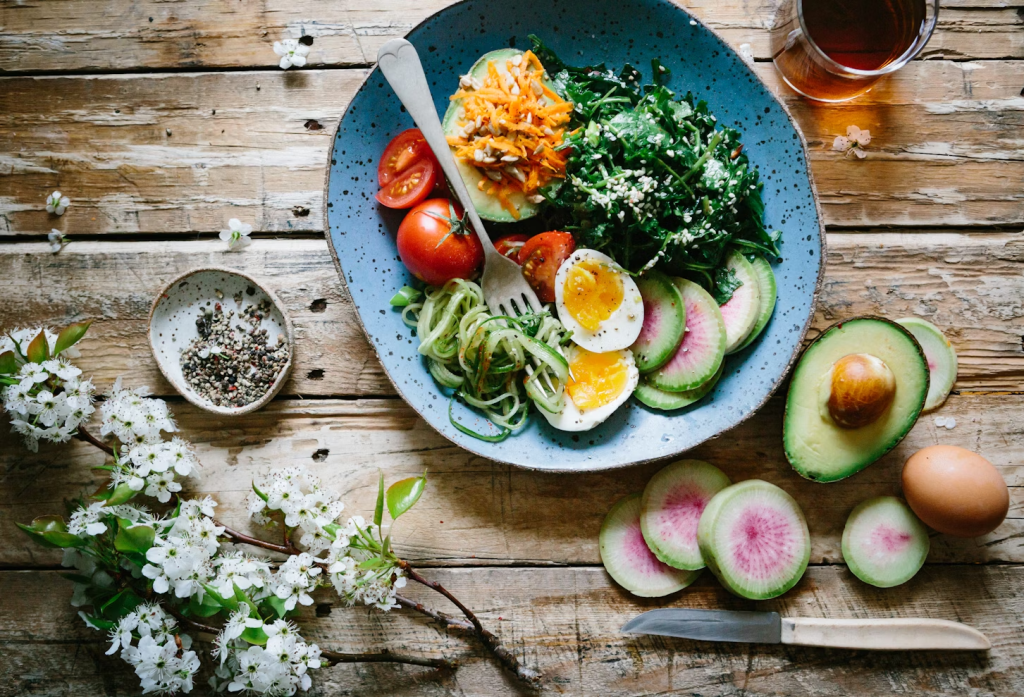
In this article, the fundamentals of the Paleo diet are dissected, including its benefits and drawbacks, as well as the potential effectiveness of the diet as a weight loss strategy.
We hope that by the time we finish this investigation into primal nutrition, we will have a better understanding of the science that underpins the Paleo diet and will be able to assess whether or not it is a viable and sustainable option for anyone who is experiencing weight loss in the modern world.
Is Paleo Good For Losing Weight?
Eating foods that our Palaeolithic ancestors may have eaten is the foundation of the Paleo diet, sometimes referred to as the Caveman or Palaeolithic diet. Lean meats, fish, fruits, vegetables, nuts, and seeds are usually included in the diet, but processed foods, grains, legumes, dairy products, and refined sugars are usually avoided.
Even though a lot of people who support the Paleo diet say it helps people lose weight and improves their general health and well-being, it’s important to approach any diet critically.
The following elements should be taken into account when evaluating the Paleo diet’s possible effects on weight loss:
High in Nutrient-Dense Foods: The Paleo diet encourages the consumption of whole, nutrient-dense foods, which can contribute to satiety and potentially lead to reduced calorie intake.
- Protein Emphasis: The diet is often rich in protein, which can help with weight management by promoting feelings of fullness and supporting muscle maintenance during weight loss.
- Reduced Processed Foods: By eliminating processed and refined foods, individuals may naturally reduce their calorie and sugar intake, contributing to weight loss.
- Potential for Improved Insulin Sensitivity: Some studies suggest that the Paleo diet may improve insulin sensitivity, which could be beneficial for weight management.
However, it’s crucial to consider the following aspects:
- Caloric Intake: Weight loss ultimately comes down to consuming fewer calories than you burn. While the Paleo diet can be nutrient-dense, it’s still possible to overeat and hinder weight loss.
- Individual Variation: The effectiveness of any diet varies among individuals. Factors such as genetics, activity level, and overall health can influence how the body responds to different dietary approaches.
- Sustainability: Long-term adherence to the Paleo diet may be challenging for some individuals due to its restrictive nature, potentially leading to difficulty maintaining weight loss over time.
- Nutrient Balance: Excluding entire food groups may pose challenges in meeting certain nutrient needs. It’s essential to ensure a balanced intake of vitamins, minerals, and other essential nutrients.
A registered dietician or other healthcare provider should be consulted before beginning any diet, including the Paleo diet. Based on each person’s tastes, underlying medical issues, and health goals, they can offer tailored advice. A balanced diet and consistent exercise are also essential for reaching and keeping a healthy weight.
What Are The Benefits Of Paleo?
Proponents of the Paleo diet believe that it is consistent with the presumed dietary patterns of our Palaeolithic ancestors, which is just one of the reasons why the Paleo diet is frequently touted for its possible health benefits. Even though different people may have different reactions to the diet, the following are some of the potential advantages connected with the Paleo diet:
Whole foods that are rich in nutrients:
- The diet encourages the consumption of whole foods, such as fruits, vegetables, lean meats, fish, nuts, and seeds, which are rich in essential nutrients, fibre, and antioxidants.
- Elimination of Processed Foods: By excluding processed foods, refined sugars, and grains, the Paleo diet may lead to a reduction in the intake of additives, preservatives, and highly processed ingredients.
- Protein Emphasis: The diet typically includes a higher intake of protein from animal sources, which can contribute to muscle maintenance, satiety, and overall body function.
- Improved Blood Sugar Control: Some studies suggest that the Paleo diet may help improve blood sugar control and insulin sensitivity, potentially benefiting individuals with conditions like insulin resistance.
- Weight Management: The emphasis on whole, nutrient-dense foods and the avoidance of processed and refined foods may contribute to weight management for some individuals.
- Reduced Inflammation: The focus on anti-inflammatory foods, such as fruits and vegetables, may contribute to a reduction in inflammation in the body.
- Better Digestive Health: The avoidance of grains and legumes, which contain certain anti-nutrients, may be beneficial for individuals with specific digestive sensitivities.
- Increased Nutrient Absorption: Some proponents argue that eliminating grains, legumes, and dairy may enhance nutrient absorption by reducing potential interference from anti-nutrients.
It is important to note that even though these potential benefits are commonly discussed, there is a lack of consensus among scientists regarding the scientific evidence that supports the Paleo diet’s superiority over other dietary regimens and its ability to be effective over the long run.
Individual responses to the diet can also vary, and due to the constraints that the Paleo diet imposes, it may be challenging for certain groups, such as vegetarians or those who have specific medical conditions, to obtain all of the nutrients that they require from the diet.
Before making significant alterations to one’s diet, it is highly recommended to consult with medical doctors or certified dietitians. They may provide advice that is specific to your objectives, present health state, and any underlying medical concerns you may have.
Conclusion
A growing number of people are adopting the Paleo diet because of its emphasis on eating foods that are raw and whole, as well as its benefits for managing weight. People who adopt a Paleo lifestyle may find it easier to lose weight since it emphasizes lean proteins, fruits, vegetables, nuts, and seeds while excluding refined and processed foods from their diet.
The diet’s high protein and nutrient-dense foods may cause people to experience feelings of fullness, which may result in a reduction in the total number of calories consumed by the individual.
Furthermore, the exclusion of some food groups, particularly processed and sugary foods, is consistent with beliefs that encourage weight loss and increased metabolic health. This makes the elimination of these food groups a viable option.
On the other hand, it is essential to employ a well-rounded strategy when following the Paleo diet. Some individuals may be able to effectively achieve their weight loss goals by utilizing this technique; however, it may be challenging for others to adhere to it for a prolonged period because it is restrictive.
Furthermore, the effectiveness of the Paleo diet varies from person to person; hence, it is essential to take into consideration personal factors such as heredity, the level of exercise one engages in, and overall health.
To ensure that one’s nutritional needs are met and that the diet plan of choice is under one’s own health goals, it is recommended that one consult with medical specialists or trained dietitians before beginning any diet.
Looking for more information? Click paleo cafes melbourne cbd now!
Which Food Is Melbourne Famous For?
Melbourne, Australia, is a culinary haven and cultural mecca on the country’s southern coast. This city’s mouthwatering cuisine is a reflection of the multicultural makeup of its residents and has earned it a reputation as a gastronomic mecca. Melbourne is home to a wide variety of cuisines, from filling breakfasts to creative brunches, cosmopolitan street food to fine dining.

Join us on a culinary adventure as we delve into the diverse food scene of Melbourne, highlighting the dishes and treats that have become the city’s signature cuisine. Take a virtual tour with us into Melbourne’s alleys, its hidden restaurants, and its busy markets, where the city’s renown as a culinary Mecca is a celebration of diversity and invention as much as it is a question of taste.
Prepare to be amazed by the hidden gems of Melbourne’s cuisine that will make your culinary bucket list soar.
Which Food Is Melbourne Famous For?
If you’re looking for a city with a vibrant and varied food culture that will satisfy any craving, go no further than Melbourne. Melbourne is well-known for its many delectable dishes, including:
- Flat Whites and Specialty Coffee: Melbourne has earned its reputation as the coffee capital of Australia. With an abundance of specialty coffee shops and a strong emphasis on quality beans and unique brewing techniques, the city has become a haven for coffee connoisseurs.
- Avocado Smash: A staple on many Melbourne brunch menus, avocado smash is a popular dish featuring mashed avocado on toast, often accompanied by additional toppings such as poached eggs, feta, or smoked salmon. This dish symbolizes the city’s love for healthy and delicious brunch options.
- Pies: Traditional Australian meat pies are a classic comfort food in Melbourne. Whether enjoyed at a local bakery, a footy game, or a casual eatery, these savoury pastries filled with minced meat and savoury gravy have become an iconic part of Melbourne’s food culture.
- Dim Sum and Dumplings: Melbourne’s Chinatown is a hub for delectable dim sum and dumplings. From traditional Cantonese flavours to modern twists, the city offers an extensive range of dumpling options, making it a paradise for dim sum enthusiasts.
- Italian Cuisine in Lygon Street: The Italian community has left an indelible mark on Melbourne’s culinary landscape, and Lygon Street is a testament to this influence. Pasta, pizza, and gelato establishments line the street, offering an authentic taste of Italy in the heart of Melbourne.
- Vibrant Food Markets: Melbourne’s food markets, such as Queen Victoria Market, are a food lover’s paradise. These markets showcase the city’s multiculturalism with stalls offering fresh produce, artisanal goods, and international street food, providing a sensory experience for visitors.
- Craft Beer Culture: Melbourne boasts a thriving craft beer scene, with numerous microbreweries and pubs serving up a variety of locally brewed beers. The city’s beer culture reflects a commitment to quality and innovation.
- Farm-to-Table Dining: Embracing the farm-to-table movement, many Melbourne restaurants prioritize locally sourced and sustainable ingredients. This commitment to fresh, seasonal produce enhances the overall dining experience.
The multicultural influences that have shaped Melbourne’s gastronomic identity have contributed to the city’s renowned cuisine, which is not limited to just one dish but rather embraces a wide spectrum of flavours. Melbourne’s food is known for its diverse range of flavour characteristics.
The city of Melbourne is a culinary journey that celebrates creativity, diversity, and a passion for good food. It is ideal for people who are passionate about coffee, brunch, and adventurous eating.
Does Melbourne Have Good Food?
Without a doubt, Melbourne’s varied and excellent cuisine is a major selling point. Not only is the city well-known as a gastronomic mecca in Australia, but it is also said to be among the world’s best. Several factors contribute to Melbourne’s stellar reputation for culinary excellence:
- Cultural Diversity: Melbourne is a melting pot of cultures, and this diversity is beautifully reflected in its food offerings. The city’s residents come from all corners of the globe, contributing to a rich tapestry of culinary influences. You can find a wide range of international cuisines, from Italian and Greek to Vietnamese, Chinese, and Middle Eastern, creating a vibrant and diverse dining experience.
- Coffee Culture: Melbourne is renowned for its coffee culture. The city takes its coffee seriously, with numerous specialty coffee shops and skilled baristas serving up high-quality brews. The flat white, a uniquely Australian coffee creation, has become a staple of Melbourne’s coffee culture.
- Innovative Brunch Scene: Brunch is practically an institution in Melbourne. The city is known for its creative and delicious brunch options, often featuring fresh, locally sourced ingredients. Avocado smash, gourmet pancakes, and inventive breakfast bowls are just a few examples of the brunch delights you can find throughout the city.
- Food Markets: Melbourne’s food markets, such as Queen Victoria Market, are a food lover’s paradise. These markets offer a diverse range of fresh produce, artisanal products, and international street food, providing a sensory feast for visitors.
- Fine Dining and Culinary Innovation: Melbourne boasts a thriving fine dining scene, with numerous award-winning restaurants that push the boundaries of culinary innovation. Renowned chefs in the city focus on using seasonal, local ingredients to create memorable and sophisticated dining experiences.
- Street Food and Food Trucks: From food trucks lining the streets to hidden laneway gems, Melbourne is a haven for street food enthusiasts. You can find everything from gourmet burgers and tacos to international street food delights, showcasing the city’s commitment to accessible and diverse culinary experiences.
- Craft Beer and Wine: The craft beer and wine scene in Melbourne is flourishing. With numerous microbreweries, pubs, and wine bars, the city caters to those who appreciate a good beverage alongside their delicious meals.
If you’re looking for great meals, go no further than Melbourne. An appreciation for variety in flavour, a commitment to quality, and new ideas are all present in the city’s restaurant scene. A culinary adventure awaits you in Melbourne, where you can please even the pickiest eateries with its abundance of hip cafés, posh restaurants, and vibrant food markets.
Conclusion
Melbourne is world-renowned for its delectable cuisine and is rightfully considered a gastronomic mecca by foodies from around the world. Melbourne has established itself as a leading destination for world-class cuisine thanks to its eclectic mix of cultures, dedication to using only the freshest ingredients, and creativity in the kitchen.
Whether you’re craving perfumed alleyways displaying different street cuisine or stylish cafés providing imaginative brunches, Melbourne’s food culture has you covered? The culinary options of the city reflect the rich tapestry of flavours created by the citizens’ different backgrounds, which is woven into the multicultural fabric of the cityscape.
The farm-to-table movement, abundant coffee culture, and sustainability emphasis in Melbourne enhance the culinary experience. Indulge in award-winning restaurants, discover hidden gems in bustling markets, and savour the latest delights in artisanal bakeries; Melbourne offers a delicious culinary trip unlike any other.
Melbourne’s culinary culture isn’t just “good”; it’s brilliant, exciting, and ever-changing. The city’s eclectic culinary scene is a reflection of its people’s enthusiasm for cooking, their imaginations, and their openness to both international and regional flavours.
Melbourne shines as a beacon for those in search of a varied and amazing gastronomic adventure, beckoning all to savour its culinary specialties and partake in a top-notch eating experience.
Do you want to know more? Click this guide “pita pan kebabs springvale” now!
What Is Melbourne Known For Food?
As a result of its multiculturalism and dedication to culinary innovation, the city of Melbourne, Australia, is famous for its lively and varied culinary scene, which offers a delicious tapestry of flavours. A testament to Melbourne’s position as a global culinary destination is its food culture, which ranges from quiet laneway cafes to bustling markets and fancy eating venues.

In this article, we will explore the delights of Melbourne’s food culture, from the city’s most famous meals to its most famous food precincts and the innovative chefs who have made it famous. Whether you’re a seasoned foodie or just looking for a new place to eat, come along as we explore the streets of Melbourne and sample some of the delicious and unusual dishes that make this city so special.
With a wide range of restaurants serving everything from traditional Australian dishes to exotic delicacies, Melbourne’s restaurant industry is a true reflection of the city’s multiculturalism and its appeal to foodies.
What Is Melbourne Known For Food?
Melbourne has a reputation for having a vibrant and creative food scene, with many distinct restaurants serving a broad variety of cuisines. The following are some of the most important factors that have contributed to Melbourne’s stellar culinary reputation:
- Coffee Culture: Melbourne is often hailed as the coffee capital of Australia. The city is home to numerous cafes, each with its own unique ambience and coffee blends. Melburnians take their coffee seriously, and the city is dotted with specialty coffee shops and skilled baristas.
- Laneway Cafes: The city is famous for its hidden laneway cafes, tucked away in narrow alleys and streets. These cafes often serve as hubs for creativity and community, offering a mix of artisanal coffees, brunch options, and eclectic atmospheres.
- Ethnic Diversity: Melbourne’s multicultural population is reflected in its food offerings. You can find a wide variety of international cuisines, from Italian and Greek to Vietnamese, Chinese, and Middle Eastern. Areas like Lygon Street (Little Italy), Chinatown, and Brunswick showcase this cultural diversity.
- Food Markets: Melbourne boasts vibrant food markets such as the Queen Victoria Market, South Melbourne Market, and Prahran Market. These markets are treasure troves of fresh produce, gourmet foods, and unique local products.
- Fine Dining: The city has a thriving fine dining scene with acclaimed restaurants and renowned chefs. Melbourne has been recognized for its culinary innovation, with a focus on locally sourced, seasonal ingredients.
- Street Food: Food trucks and street food markets contribute to Melbourne’s dynamic food landscape. You can explore a variety of global street food offerings at events like the Melbourne Food Truck Festival.
- Iconic Dishes: Melbourne has its share of iconic dishes, including the traditional Australian meat pie, which can be found in many bakeries and cafes across the city. The “parma” (chicken parmigiana) is another popular pub-style dish.
- Wine and Craft Beer: The city is home to numerous wine bars and craft breweries, showcasing a growing interest in locally produced wines and beers. Melbourne’s laneways often host hidden bars and speakeasies, adding to the city’s nightlife allure.
The culinary landscape of Melbourne is characterised by an abundance of variety, originality, and camaraderie. Foodies in search of culinary experiences and those in search of a more informal eating experience will both find what they’re craving in Melbourne.
Is Melbourne A Foodie City?
Without a doubt, Melbourne is well-known as a gastronomic Mecca, not only in Australia but around the world. The city’s culinary scene is lauded for its variety, creativity, and dedication to excellence. Some reasons why Melbourne is a paradise for foodies are:
- Cultural Diversity: Melbourne’s population is incredibly diverse, and this diversity is reflected in its culinary offerings. The city is home to a wide range of ethnic communities, leading to a rich tapestry of international cuisines available in its restaurants and markets.
- Coffee Culture: Melbourne is often regarded as the coffee capital of Australia. The city has a strong coffee culture with a plethora of specialty coffee shops, talented baristas, and a high standard of coffee quality.
- Innovative Dining: Melbourne’s chefs are known for their creativity and innovation. The city’s fine dining scene has gained international recognition, and chefs often showcase a commitment to using locally sourced, seasonal ingredients.
- Laneway Culture: The laneways of Melbourne are not just aesthetically pleasing; they are also home to hidden cafes, bars, and eateries. These laneway establishments contribute to the city’s vibrant and unique food culture.
- Food Markets: Melbourne boasts iconic food markets, such as the Queen Victoria Market, which offers a wide array of fresh produce, gourmet foods, and artisanal products. These markets are a popular destination for locals and tourists alike.
- Food Festivals and Events: Melbourne hosts numerous food festivals and events throughout the year, celebrating everything from street food to fine dining. Events like the Melbourne Food and Wine Festival showcase the city’s culinary prowess.
- Street Food and Food Trucks: The city’s streets come alive with food trucks and street food markets, providing a diverse range of quick and tasty options for food enthusiasts.
- Craft Beer and Wine: Melbourne has a thriving craft beer and wine scene, with many bars and breweries offering locally produced beverages. The city’s laneways are often home to hidden bars and speakeasies, adding to the overall experience.
It’s no wonder that foodies from all over the globe flock to Melbourne to sample the city’s varied and exciting cuisine. The city’s reputation as a gastronomic Mecca is justified.
Conclusion
A city that takes great pride in its reputation as a culinary destination, Melbourne is well-known for its vibrant and diverse food scene. A cosmopolitan population, innovative restaurants, and a passion for high-quality coffee are the factors that have contributed to the city’s reputation as a culinary paradise.
A culinary wonderland, Melbourne is home to a wide variety of eateries that cater to a wide range of preferences, from little cafés hidden away in alleyways to enormous food markets.
A dining experience that is both exceptional and one-of-a-kind is produced by the city’s rich tapestry of various cuisines, which is a reflection of the city’s global fabric. The commitment of Melbourne’s chefs to using fresh, locally produced ingredients and their ongoing commitment to innovation in the kitchen have contributed to the city’s rise to prominence as a global leader in the field of fine dining.
Melbourne is widely recognised as the coffee capital of Australia. This reputation is attributed, in part, to the city’s thriving coffee culture, as well as the plethora of specialty coffee shops and skilled baristas that can be found inside its borders.
In addition to being visually stunning, the laneways of Melbourne are home to an abundance of hidden gems that make a substantial contribution to the city’s dynamic and ever-evolving food culture.
When it comes to gastronomic adventures, Melbourne is a city that welcomes both locals and visitors alike. Whether it’s trying foreign tastes, trying famous Australian dishes, or enjoying the delights of food markets and festivals, Melbourne has something to offer everyone.
The city of Melbourne continues to attract a large number of foodies due to the city’s commitment to sustainability and innovation, as well as its thriving craft beer and wine sector. This is because the city offers a plethora of experiences that are both distinctive and delicious.
An excursion to Melbourne is an absolute necessity for everyone who is looking for a sensory adventure for themselves. One of the reasons that the city has earned the image of being a “foodie” is because its citizens enjoy trying out new foods.
For more information, click this guide “internet”.
Spicy, yummy & Tasty
Lorem ipsum dolor sit amet, consectetur adipiscing elit, sed do eiusmod tempor incididunt ut labore et dolore magna aliqua.
takeout menu
Lorem ipsum dolor sit amet, consectetur adipiscing elit.







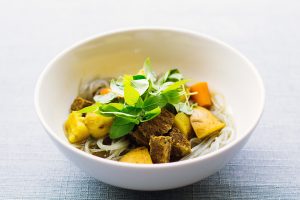
Lorem ipsum dolor sit amet, consectetur adipiscing elit, sed do eiusmod tempor incididunt ut labore et dolore magna aliqua. Ac turpis egestas integer eget aliquet nibh praesent tristique. In cursus turpis massa tincidunt dui.

